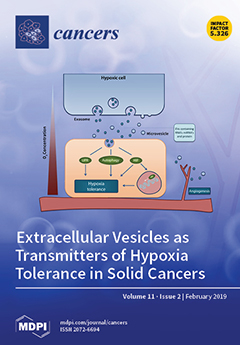In the human genome,
miR-451a is encoded close to the
miR-144 on chromosome region 17q11.2. Our previous study showed that both strands of pre-
miR-144 acted as antitumor miRNAs and were involved in lung squamous cell carcinoma (LUSQ) pathogenesis. Here, we aimed to
[...] Read more.
In the human genome,
miR-451a is encoded close to the
miR-144 on chromosome region 17q11.2. Our previous study showed that both strands of pre-
miR-144 acted as antitumor miRNAs and were involved in lung squamous cell carcinoma (LUSQ) pathogenesis. Here, we aimed to investigate the functional significance of
miR-451a and to identify its targeting of oncogenic genes in LUSQ cells. Downregulation of
miR-451a was confirmed in LUSQ clinical specimens, and low expression of
miR-451a was significantly associated with poor prognosis of LUSQ patients (overall survival:
p = 0.035, disease-free survival:
p = 0.029). Additionally, we showed that ectopic expression of
miR-451a significantly blocked cancer cell aggressiveness. In total, 15 putative oncogenic genes were shown to be regulated by
miR-451a in LUSQ cells. Among these targets, high kinesin family member 2A (
KIF2A) expression was significantly associated with poor prognosis (overall survival:
p = 0.043, disease-free survival:
p = 0.028). Multivariate analysis showed that
KIF2A expression was an independent prognostic factor in patients with LUSQ (hazard ratio = 1.493,
p = 0.034). Aberrant
KIF2A expression promoted the malignant transformation of this disease. Analytic strategies based on antitumor miRNAs and their target oncogenes are effective tools for identification of novel molecular pathogenesis of LUSQ.
Full article






